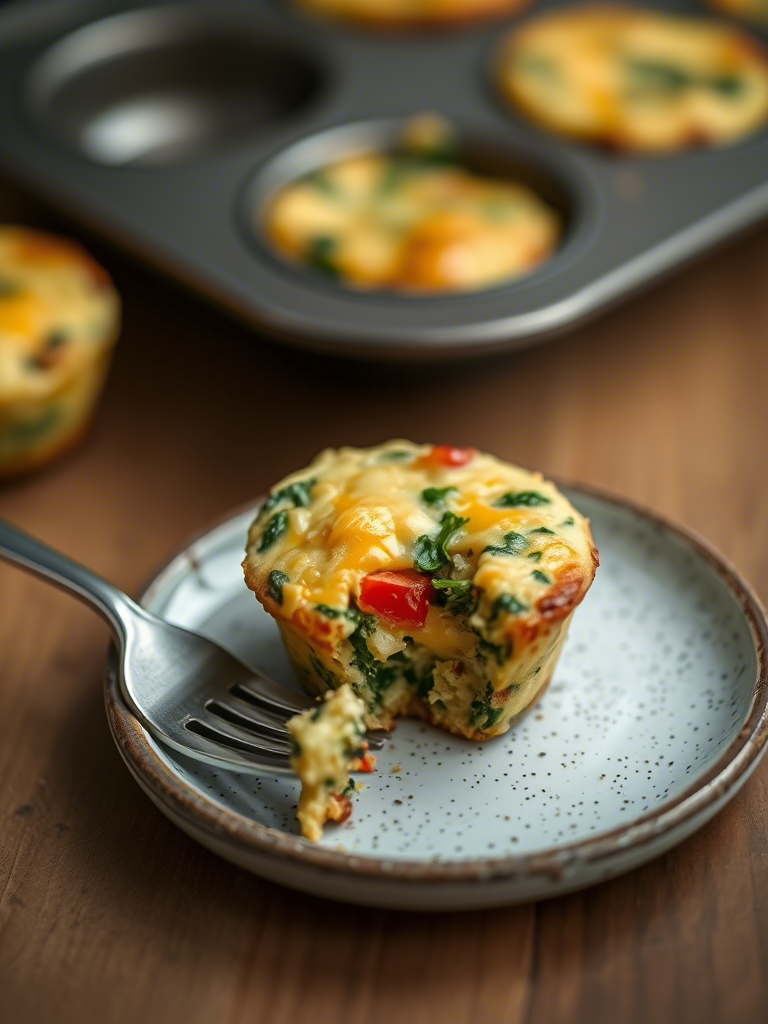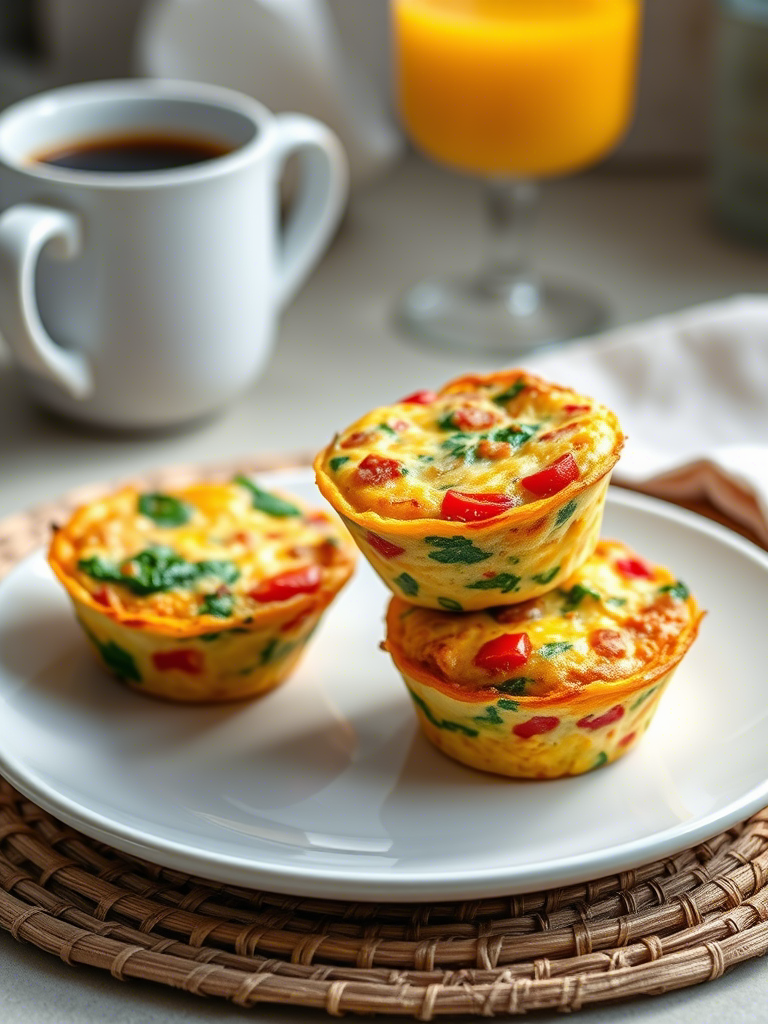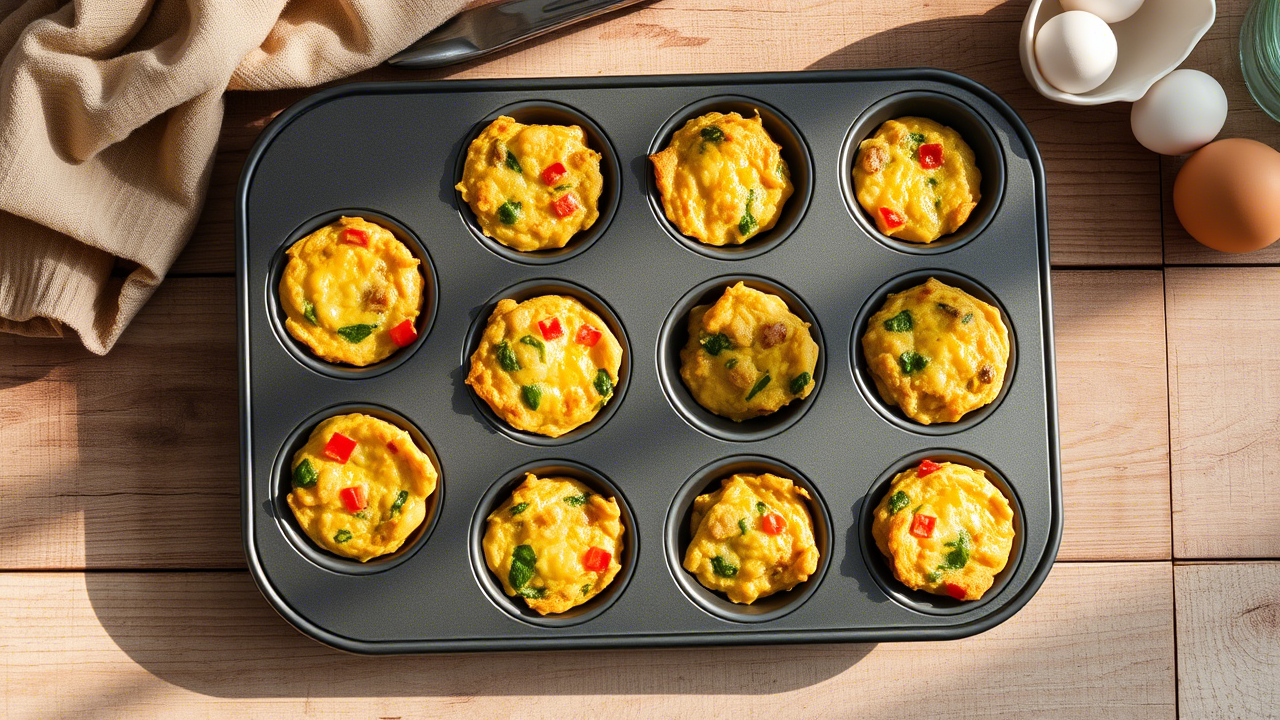Breakfast is often hyped as the most important meal of the day—and for good reason. But for chefs and nutrition-minded cooks, there’s an unspoken challenge: how to deliver something fast, flavor-packed, and nutritionally dense in a small, grab-and-go format. Enter veggie-loaded breakfast frittata cups. These tiny, eggy marvels are more than just cute muffin-shaped meals. They’re protein-rich, veggie-stuffed, and endlessly customizable. But more importantly, they’re rooted in a solid culinary technique that deserves attention.
Let’s break it all down. Not with fluff. With real kitchen wisdom.
Why Frittata Cups Deserve a Place in Your Repertoire
You know what’s easier than a pan-fried egg? A dozen frittata cups made all at once in a standard muffin tin. No flipping. No babysitting. Just whisk, pour, bake, done. That’s what makes these ideal in both commercial kitchens and meal prep operations. And they scale like a dream—batch cooking 60 at once is just as simple as making six.
Here’s the kicker: frittata cups are one of the few breakfast options that can tick all the boxes. Gluten-free. Keto-friendly. Vegetarian. High-protein. Low-carb. And most importantly: damn tasty.
According to the USDA FoodData Central, one large egg packs about 6.3 grams of protein, while veggies like spinach, bell peppers, and broccoli bring in fiber, vitamins A and C, folate, and antioxidants. Stack that up in a frittata cup, and you’re delivering macro- and micro-nutrients in a few bites. It’s not just smart. It’s elite-level cooking.
But technique matters. And that’s where most home cooks and even some pros trip.
The Egg Base: Not Just “Whisk and Pour”
Let’s talk egg ratios. If your frittata cups puff too much and deflate like a popped tire, you’re either over-beating or adding too much dairy. That’s rookie stuff. The ideal egg-to-dairy ratio? Around 6 large eggs to 1/4 cup of liquid. Go heavier on dairy, and you’re inviting watery bottoms and rubbery textures.
Skip cream unless you’re looking for richness. Whole milk or unsweetened almond milk does the job cleaner. Want fluffiness? Add a tablespoon of Greek yogurt. It’s protein-rich, adds tang, and doesn’t water things down. That’s a tip straight outta my culinary school days.
Also—don’t salt the eggs too early. Salt draws out moisture and makes the batter runny if it sits too long. Whisk right before you pour.
Veggie-Loading Without the Sog
Now, loading veggies into eggs seems simple. But raw veg can destroy a frittata’s structure. You want sautéed or roasted veg. Always. No exceptions.
Let’s use spinach as a case study. Raw spinach looks fine going in—but gives off a ton of water as it cooks. Result? Soggy, eggy puddles. A quick wilt in a dry skillet or a 3-minute roast in a 400°F oven fixes that. Press out the excess moisture with a paper towel. Or better yet, give it a light squeeze in cheesecloth.
Bell peppers? Roast or sauté ‘em. Broccoli? Blanch or roast, never raw. Mushrooms? Always cook them first to release their moisture and concentrate their umami. If you’re thinking, “That’s a lotta prep for a muffin tin of eggs,” you’re right. But that’s where the depth of flavor lives.
You don’t build greatness with shortcuts. You layer it with intention.

Cheese: A Binder, Not Just a Topping
Let’s get controversial: not all cheeses belong in a frittata cup. Mozzarella? Too much moisture. Feta? Hell yes. Cheddar? Sharp and stable. Parmesan? Underrated MVP.
The cheese should do two things: enhance flavor and help bind the structure. A salty cheese like feta or Parm adds depth without weighing things down. And here’s the trick most folks miss—grate the cheese super fine. Microplane-style. It distributes evenly and melts seamlessly into the eggs. No clumpy surprise pockets. You’re welcome.
And don’t just drop it on top. Mix half into the egg base and save the rest for a light top layer. That’s what gives you that photogenic golden brown crust. And flavor. Loads of it.
The Muffin Tin Dilemma: Stick or Slide?
Let’s be real—cleaning crusty egg from a muffin tin is hell. Don’t go there.
Always use silicone muffin liners or a nonstick pan with a light brush of oil. Baking spray works too, but don’t overdo it or you’ll get weird brown spots on the sides. If you’re cooking for clients or selling these in bulk, aesthetics matter. No one wants a raggedy-looking frittata cup.
Also, cool them in the pan for 5 minutes before unmolding. That brief rest lets the proteins tighten and makes removal smooth. If they’re still hot, they’ll tear like wet paper.
Professional Variations That Elevate the Game
Let’s get creative now—without being gimmicky.
Mediterranean Style: Spinach, sun-dried tomato, kalamata olives, feta. Sprinkle with za’atar before baking. It’ll blow people’s minds.
Southwest Kick: Roasted poblanos, corn, black beans, pepper jack cheese. Dash of smoked paprika. Maybe a cilantro drizzle after baking.
Miso-Mushroom Umami Bomb: Shiitakes, miso paste, scallions, sesame oil. Topped with shredded nori. Fusion magic.
French Market: Leeks, goat cheese, thyme, a whisper of nutmeg. Subtle. Sophisticated. Not for rookies.
What you don’t do: overload. Keep the veggie-to-egg ratio sensible. About 1 cup of chopped cooked veg per 6 eggs is the sweet spot. Beyond that, you’re making soup in a cup.
Storage and Reheating: How to Preserve That Just-Baked Texture
Here’s a mistake too many make: storing frittata cups uncovered in the fridge. They dry out faster than a stale croissant.
Wrap them individually in parchment or store in an airtight container with a paper towel underneath to absorb moisture. They’ll keep for 4-5 days in the fridge. Freeze? Yep. But only if wrapped tight and double-bagged to prevent freezer burn. Reheat in a 350°F oven for 10 minutes or zap in the microwave with a damp towel over top to avoid rubbery bites.
Never reheat them straight from the fridge without bringing them to room temp for 5-10 minutes. Cold eggs plus high heat = texture nightmare.
Common Missteps—and How Pros Avoid Them
1. Overbaking.
You’re not making soufflé here. Bake until the center just stops jiggling. They’ll continue to cook in the pan. Overbake, and you’ve made egg jerky.
2. Using watery vegetables.
Zucchini, tomatoes, fresh spinach—these need to be cooked and drained. Period. Or you’ll end up with bottom-sog central.
3. Inconsistent cup sizes.
If you’re portioning with a spoon, stop. Use a measuring cup or a batter dispenser. Uniformity matters, especially in commercial kitchens or catering jobs.
4. Forgetting seasoning.
Salt, pepper, herbs—don’t be shy. Eggs are blank canvases. Without seasoning, even the best ingredients fall flat.

Nutritional Brilliance That’s Not Just Hype
Let’s run some numbers, chef-style.
A standard veggie-loaded frittata cup with 1 egg, sautéed spinach, bell pepper, and a touch of feta delivers:
- ~90-110 calories
- 6–7g protein
- 1–2g carbs
- 6g fat (mostly healthy, especially if you use olive oil)
- Vitamin A, C, and folate off the charts
Compare that to a breakfast sandwich from a fast-food joint (~300–500 calories, less protein, processed carbs). There’s no competition. You’re serving nutrition in a tuxedo.
For the Restaurant Crowd: Why Add This to Your Brunch Menu?
Minimal prep. No special equipment. Works for grab-and-go or plated breakfast. And the margin is solid. Eggs and veg are cheap. Toss in a touch of premium cheese, charge $4–6 a portion with some salad or toast on the side, and you’ve got a high-ROI item with low waste.
Also, they reheat beautifully—so you can prep the night before service. Just re-warm gently, top with microgreens or a quick aioli swirl, and boom. Instagram-ready.
For Meal Preppers and Health Coaches: A Staple Worth Preaching
Clients love ‘em. Easy to prep. Perfectly portioned. Customizable for macro goals.
Want low fat? Skip the cheese and use egg whites. Keto? Add avocado and bacon. Vegetarian? You already nailed it. Vegan? You’ll need chickpea flour or JUST Egg—but that’s another article entirely.
Final Takeaways and Pro Tips
- Always pre-cook veggies. Don’t skip this.
- Use silicone or nonstick pans to avoid tragic cleanup.
- Don’t overfill. Eggs expand. A ¾-full cup is ideal.
- Flavor matters. Salt, herbs, spice—it’s not optional.
- Cool before removing. Let the structure set.
So next time you’re staring down a breakfast menu—or planning a week’s worth of meals—don’t underestimate the humble frittata cup. It’s a culinary workhorse with finesse. Small? Yep. But mighty. And in the right hands, it’s a statement piece on a plate.
Now go crack some eggs.
FAQs
What are veggie-loaded breakfast frittata cups?
They’re mini baked egg muffins packed with cooked vegetables and sometimes cheese, ideal for quick, healthy breakfasts.
Can I use raw vegetables in frittata cups?
No, always cook veggies first to avoid soggy, watery results.
How long do frittata cups last in the fridge?
They stay fresh for 4–5 days in an airtight container.
Can I freeze frittata cups?
Yes, wrap tightly and freeze for up to 2 months for best quality.
What’s the best egg-to-dairy ratio?
Use about 6 eggs to 1/4 cup of dairy or yogurt for perfect texture.
How do I prevent frittata cups from sticking?
Use silicone liners or a well-oiled nonstick muffin tin.
Are these frittata cups keto-friendly?
Yes, they’re naturally low in carbs and high in protein and fat.
Can I make them dairy-free?
Yes, skip the cheese and use a non-dairy milk like almond or oat.
How should I reheat frittata cups?
Warm in a 350°F oven for 10 minutes or microwave with a damp towel.
Can I use just egg whites?
Yes, but the texture will be lighter and slightly less rich.
Why did my frittata cups collapse?
They were either overbeaten or overbaked—try mixing gently and baking just until set.
What kind of cheese works best?
Feta, Parmesan, or cheddar add flavor and structure without too much moisture.
Do frittata cups work for meal prep?
Absolutely—they’re portable, easy to store, and reheat well.
Can I add meat to the frittata cups?
Yes, cooked bacon, sausage, or ham are great add-ins.
How much veggie should I use per batch?
Roughly 1 cup of cooked vegetables per 6 eggs is ideal.

Mariana is a passionate home cook who creates delicious, easy-to-follow recipes for busy people. From energizing breakfasts to satisfying dinners and indulgent desserts, her dishes are designed to fuel both your body and hustle.
When she’s not in the kitchen, she’s exploring new flavors and dreaming up her next recipe to share with the Foodie Hustle community.

